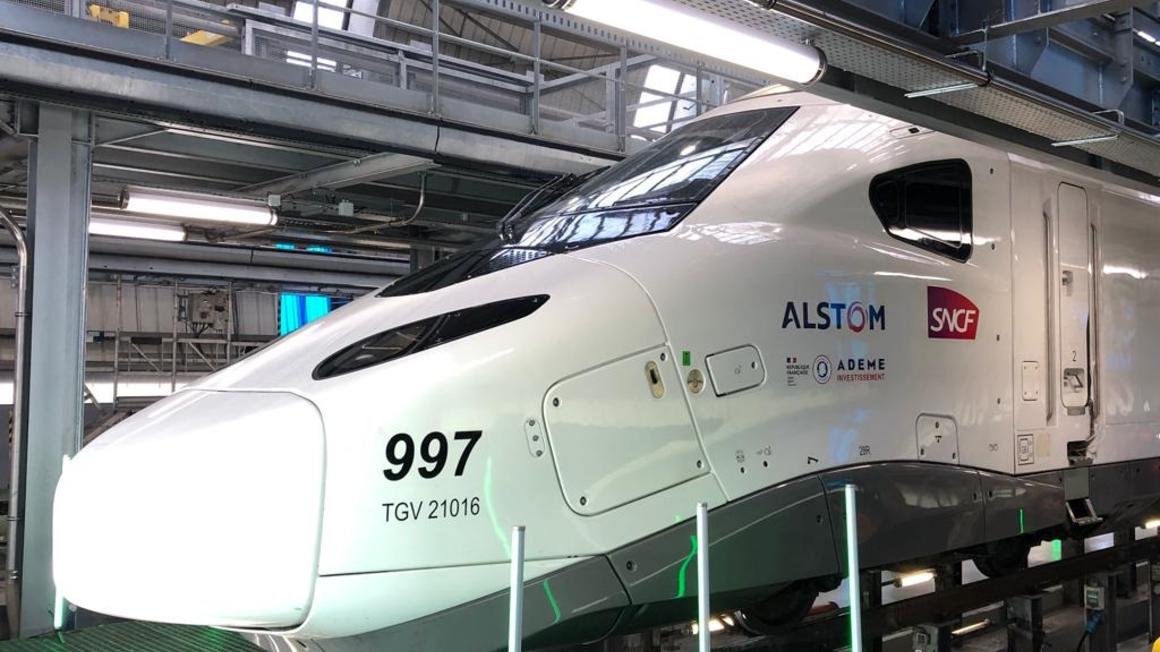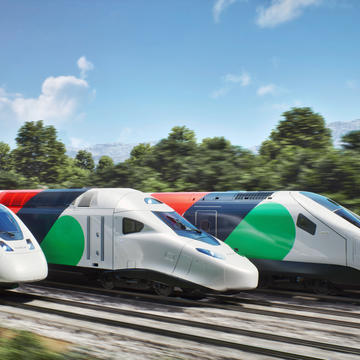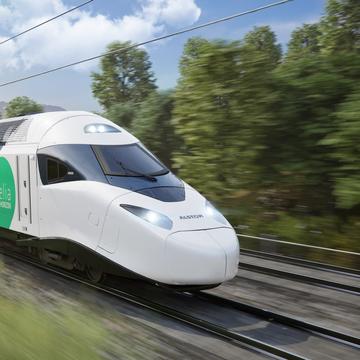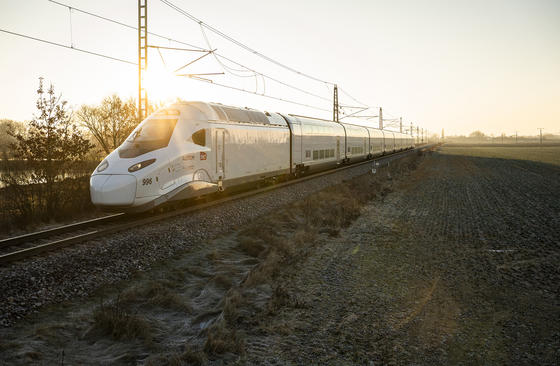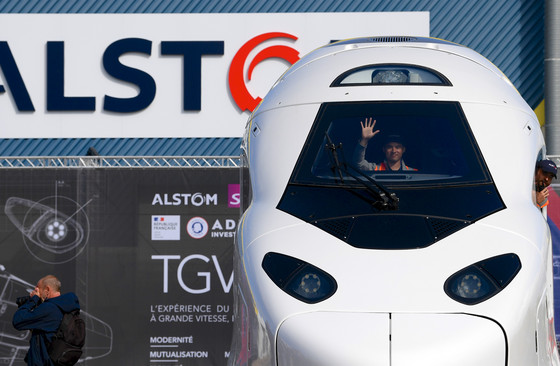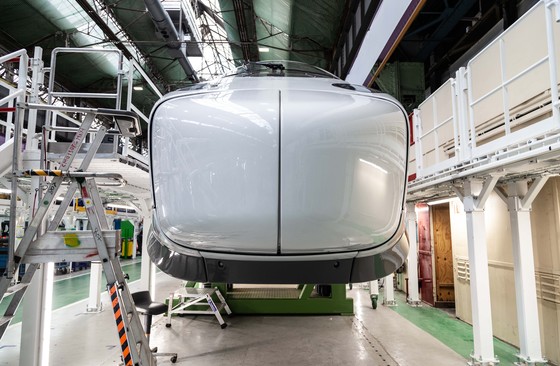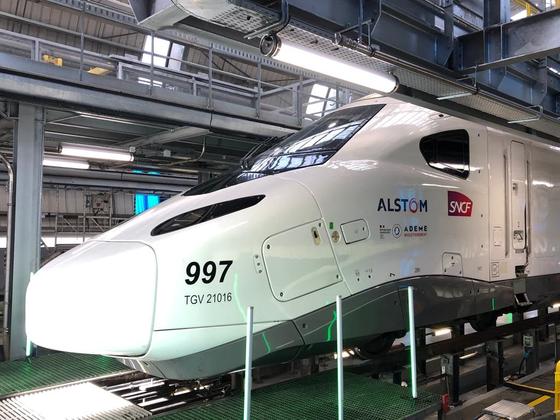
TGV M tests accelerate on the French national railway network
Press contact - Philippe Molitor
Philippe Molitor
Send an emailPress contact - Western France
Anne-Cécile Jourdan
Send an emailSince June 2023, the future INOUI TGV (5th generation rolling stock, named TGV M) has been undergoing tests on the French national railway network. This campaign, which is being stepped up with the arrival of a new test train, will last until the end of 2023, before the acceptance test phase in 2024.
The TGV M, the future INOUI TGV, from Alstom’s Avelia Horizon range, is entering a new phase of testing. Ordered by SNCF Voyageurs for 115 trainsets at a cost of around 3.5 billion euros, it represents the 5th generation of TGVs and the realisation of a historic industrial and innovation project between SNCF Voyageurs and the French designer and manufacturer Alstom. It will be rolled out over ten years, starting in 2025, with the first trains running on the Paris-Lyon-Marseille line.
A series of tests required before commercial release
In December 2022, pre-validation tests began at the Velim site, in the Czech Republic. On this closed circuit, the aim was to validate for the first time the train’s overall operation at speeds of up to 200 km/h.
In March 2023, the future INOUI high-speed train travelled to Vienna for climatic tests. These trials enabled the future train to be tested at extreme temperatures (between -20°C and +40°C). They are critical in the current climate change context, as they will enable us to assess the energy efficiency of the future INOUI TGV. The train’s resistance to climatic constraints will make an active contribution to the objective of reducing the energy consumption of the future INOUI TGV by 20%.
Since June 2023, pre-validation tests have moved to the French national railway network (Réseau Ferré National). They will last until December 2023. They consist of testing and, if necessary, adjusting the train’s operation, with trains travelling at speeds of up to 320 km/h.
Two trains are used for this purpose:
- The first train has been running since June 2023, enabling the shunting, energy collection through pantograph, traction, and braking functions to be assessed and validated. It is this train that ran for the first time at the maximum commercial speed of 320km/h, on 14 September 2023 at 3.47pm.
- In October 2023, the pre-validation tests will accelerate with the first runs of a second train.
This will enable all the train’s safety equipment to be validated.
This new test train is covered with two special liveries (at each end of the train), designed by SNCF Voyageurs and Alstom staff respectively, and will be visible on the Sud Europe Atlantique high-speed line until mid-November.
Throughout this period, between 25 and 30 technicians and engineers will be on board to make up the train testing team: experts from SNCF Voyageurs’ Rolling Stock Engineering and Alstom teams, drivers, etc.
From January to July 2024, admission tests will be carried out, which consist of testing the operation of the trainset by reproducing the configurations and contexts that it may encounter throughout the real life of the train (single unit, multiple unit, degraded modes, weather conditions, singular points on the network, etc.). They will be conducted by an accredited body on the French national railway network, with traffic running at up to 320 km/h. The admission tests will be used to receive the Marketing Authorisation issued by ERA (the European Railways Agency).
Finally, from autumn 2024, over an extended period prior to the start of commercial service, several trainsets will run throughout the network as part of pre-operation tests. These will assess the train’s reliability under operating conditions. All functions will be tested, in particular those relating to passenger comfort. These tests, which will be conducted with the first 4 production trains, will also be an opportunity for drivers and conductors to familiarise themselves with this new train and its innovations.
At the end of all these tests, the future INOUI TGV will have benefited from 350 weeks of cumulative testing and will have covered more than a million kilometres before the first customer experiences the SNCF Voyageurs high-speed train of tomorrow.
State-of-the-art maintenance centres
SNCF Voyageurs has embarked on a major programme to modernise its maintenance centres to accommodate the future INOUI TGV. This work involves adapting maintenance facilities to make them compatible with the future train, for example by installing automated benches that can check several hundred parts in a few seconds. The ecological aspect is also very much present in these investments, and optimal solutions from an energy point of view are encouraged.
The ‘Technicentre Sud Est Européen’ (TSEE), which welcomed the first TGVs in 1981, will be the first to welcome the future INOUI TGV. With its 850 employees, it maintains nearly a quarter of the SNCF Voyageurs TGVs running in France, Italy, Switzerland, Spain, and Germany.
The TSEE modernisation project involves investment of nearly €300 million (from 2023 to 2027) and represents the standard for a new generation of maintenance technicentre for SNCF Voyageurs, more modern, more connected, but also more ecological, like the TGV M.
More environmentally friendly, as 64% of the TSEE buildings will be heated by renewable energies and 4,000 m² of photovoltaic panels will cover the Technicentre’s future car park roof.
The TSEE will also be integrated into its neighbourhood by creating a biodiversity corridor between the Bois de Vincennes and the Seine, in Paris.
The first phase of the TSEE 4.0 work focused on adapting the 2-track workshop, which can accommodate the future INOUI TGV since July 2023. For this phase, Alstom provided its expertise to SNCF Voyageurs to take into account the specific features of the future INOUI TGV.
The future INOUI TGV promises to usher in a new era in TGV maintenance. It will be a communicating trainset that will provide permanent remote access to technical data and clear information on the state of each of its components. This will make it possible to plan maintenance operations based on the actual condition of the components, and to anticipate breakdowns in doors, air conditioning and, more generally, all the systems that contribute to train operation and passenger comfort.
The TGV maintenance profession will also change with the arrival of the future INOUI TGVs. The day-to-day life of technicians will change, as they will literally be talking to a train, able to explain its problems. Their diagnosis will be more detailed and precise. And work organisation will be made easier because it will be possible, thanks to the data analysis, to anticipate the treatment of a trainset in all its aspects: tools, tasks to be conducted, necessary intervention time.
Alstom launches industrial innovations for the 5th generation of TGVs
To conduct the industrial innovations associated with this new TGV project, Alstom has introduced new industrial processes:
- At Alstom’s Belfort site, the creation of a new multi-purpose line dedicated to the new TGV power car. This single line makes it possible to rationalise the footprint of the manufacturing facilities by reducing it by 6,000 m2, automatically resulting in lower electricity and heating consumption.
- At Alstom’s La Rochelle site, the creation of a new assembly line for passenger cars. This is a model production line for the rail industry, driven by continuous improvement, which has resulted in greater efficiency, simplified assembly, operator safety and ergonomic workstations. This model line also enables the footprint of the manufacturing facilities to be rationalised, and the associated electricity and heating consumption to be reduced. An office area for support functions (engineering, industrialisation, supply chain, etc.) has also been created as close as possible to the assembly line.
10 French Alstom sites are contributing to this flagship project: La Rochelle and Belfort, as well as Villeurbanne, Ornans, Le Creusot, Tarbes, Petit-Quevilly, Toulouse, Valenciennes, and Saint-Ouen.
Innovations for functional train validation, excluding the physical train
A test laboratory called “TrainLab” has been developed at Alstom’s La Rochelle site: functional validation of the train via a “digital twin” is conducted there, without requiring validation on the real train. This laboratory makes it possible to anticipate the validation of the functional train (operation of doors, air conditioning, etc.).

